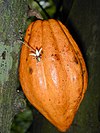White chocolate
 Pieces of white chocolate | |
| Type | Chocolate |
|---|---|
| Course | Dessert |
| Place of origin | Switzerland |
| Created by | Nestlé |
| Main ingredients | Cocoa butter, sugar, milk solids |
| Ingredients generally used | Vanilla |
White chocolate is a chocolate confection, pale ivory in color, made from cocoa butter, sugar, milk solids and sometimes vanilla.[1] White chocolate does not contain cocoa solids, which are found in other types of chocolate,[1] such as milk chocolate and dark chocolate. It is solid at room temperature 25 °C (77 °F) because the melting point of cocoa butter, the only cocoa bean component of white chocolate, is 35 °C (95 °F).[2]
History[]
In 1936, the white chocolate Galak was launched in Europe by the Swiss company Nestlé.[3] Other companies developed their own formulas, such as that developed by Kuno Baedeker for the Merckens Chocolate Company in 1945.[4]
From about 1948 until the 1990s, Nestlé produced a white chocolate bar with almond pieces, Alpine White, for markets in the United States and Canada.[3] Hershey began mass production of white Kisses in the 1990s, a product that diversified during the early 21st century to include a chocolate white-dark swirl Kiss called the Hug.[3][5]
Composition[]
White chocolate does not contain cocoa solids, the primary non-fat constituent of conventional chocolate liquor — chocolate in its raw, unsweetened form. During manufacturing, the dark-colored solids of the cocoa bean are separated from its fatty content, as with milk chocolate and dark chocolate, but, unlike with other forms of chocolate, no cocoa mass is added back; cocoa butter is the only cocoa ingredient in white chocolate. White chocolate contains only trace amounts of the stimulants theobromine and caffeine which are present in the cocoa mass but not the butter.[6] Flavorings such as vanilla may be added to white chocolate confectionery.[7] Caramelized white chocolate is called "blonde chocolate" and has a different flavor profile.[8]
Regulations[]
Regulations govern what may be marketed as white chocolate: Since 2000 in the European Union, white chocolate must be (by weight) at least 20% cocoa butter, 14% total milk solids, and 3.5% milk fat.[9] As of May 2021, the European Food Safety Authority proposed banning the food coloring agent, E171 (titanium dioxide), used as a common whitener in some white chocolate products.[10]
Since 2004 in the United States, the Code of Federal Regulations defined that white chocolate should contain "not less than 20 percent by weight of cacao fat", "not less than 3.5 percent by weight of milkfat and not less than 14 percent by weight of total milk solids", and "not more than 55 percent by weight of a nutritive carbohydrate sweetener."[11] Acceptable dairy elements when manufacturing white chocolate in the United States include evaporated milk, skim milk, buttermilk, or malted milk. White chocolate products may not contain artificial coloring agents.[11]
See also[]
References[]
- ^ a b "White chocolate". Bon Appétit. 12 November 2007.
- ^ "Physical and chemical information on cocoa beans, butter, mass and powder". www.icco.org. Retrieved 2 October 2020.
- ^ a b c "The history Of white chocolate". The Nibble. The World's Best White Chocolate. 1 April 2008. Retrieved 2 August 2013.
- ^ "Chocolate-Loving Couple Settled Here" (PDF). Lake Placid News (PDF). Lake Placid, New York. 19 March 1987. p. 8. Retrieved 2 August 2013.
- ^ Rachel Janik (14 February 2015). "How the Hershey's Kiss conquered Valentine's Day". Time. Retrieved 31 December 2019.
- ^ Zoumas, Barry; Kreisler, Wesley; Martin, Robert (1980). "Theobromine and Caffeine Content of Chocolate Products". Journal of Food Science. 45 (2): 314–316. doi:10.1111/j.1365-2621.1980.tb02603.x.
- ^ Blumberg, Naomi. "Chocolate". Encyclopædia Britannica Online. Retrieved 28 July 2015.
- ^ Filloon, Whitney (9 February 2018). "Caramelized White Chocolate Is for People Who Hate White Chocolate". Eater. Retrieved 31 October 2021.
{{cite web}}: CS1 maint: url-status (link) - ^ "Directive 2000/36/EC of the European Parliament and of the Council of 23 June 2000 relating to cocoa and chocolate products intended for human consumption". Retrieved 27 October 2010.
- ^ "EFSA considers E171 food additive no longer safe". European Food Safety Authority. 6 May 2021. Retrieved 7 May 2021.
- ^ a b "Title 21, Chapter I, Subchapter B, Part 163.124 (white chocolate) of the US Code of Federal Regulations". United States Government Publishing Office. 5 May 2021. Retrieved 7 May 2021.
External links[]
 Media related to White chocolate at Wikimedia Commons
Media related to White chocolate at Wikimedia Commons
- Swiss chocolate
- Swiss cuisine
- Swiss inventions
